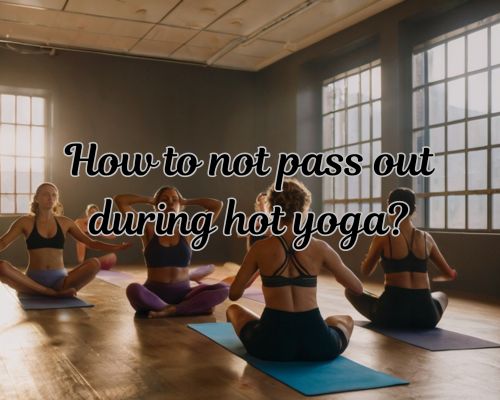How to Not Pass Out During Hot Yoga:

Essential Tips for a Safe Practice
Hot yoga offers numerous benefits for both your body and mind. It can increase your strength, flexibility, and reduce stress. Practicing in a heated room amplifies these benefits, but it also presents challenges that can be daunting, especially if you’re new to it.

Understanding how to stay safe and avoid passing out is crucial to enjoying and gaining the full benefits of hot yoga.
To avoid passing out during hot yoga, it’s essential to stay hydrated before, during, and after your session. This means drinking plenty of water and replenishing lost electrolytes.
Jane Benson from Bikram Yoga Mornington highlights that wearing light, breathable clothing and taking breaks in child’s pose can help you manage your body’s temperature more effectively. Keeping a wet towel handy to wipe your face can also assist in cooling down your core temperature.
Preparing for Hot Yoga
To ensure a safe and efficient hot yoga session, it’s essential to prepare thoroughly. This includes understanding the basic principles of hot yoga, hydrating properly, choosing the right attire, and mentally and physically preparing yourself.
Understanding the Basics
Hot yoga typically involves practising in a room heated to around 35-40 degrees Celsius with high humidity. Bikram Yoga is a well-known style that follows a set sequence of 26 postures and two breathing exercises.
Other forms, like Hatha Yoga, can vary in their sequences and temperature settings. Knowing your body’s range of motion and limits is crucial, especially for beginners. Consistency and regular practice will help you acclimate to the heat.
Hydration and Nutrition
Staying hydrated is critical. Begin hydrating well before class with water or electrolytes like coconut water. Avoid caffeine-laden drinks as they can dehydrate you.
A light, nutrient-rich snack such as a piece of fruit or a protein bar can provide the energy needed for your session.
During the class, sip fluids as needed to maintain hydration levels. Post-yoga hydration is equally important for recovery and maintaining electrolyte balance.
Appropriate Attire
Wear lightweight, breathable clothing from brands like Lululemon that allow sweat to evaporate and let your body stay cool. A grip-enhanced yoga mat helps maintain posture and balance.
Suggested Items:
- Lightweight, moisture-wicking clothing
- Grip-enhanced yoga mat
- Absorbent towel for sweat
- Water bottle for hydration
Mental and Physical Preparation
Mental readiness is as important as physical preparation. Start with meditation or breathing exercises to centre your focus. This mindfulness will help you respond better to the heat and humidity.
Physically, engage in gentle stretching before class to prepare your muscles for the intense yoga sequence.
Listen to your instructor and your body, taking breaks if you feel dizzy or lightheaded. Practising mindfulness and understanding your limits will help you stay safe and avoid passing out.
If you don’t have an instructor yet, you can go and visit Jane Benson from Bikram Yoga Mornington.
During the Practice
Stay mindful of your body’s responses and maintain proper hydration and breathing to maximise the benefits of your hot yoga practice, while ensuring your safety.
Maintaining Focus and Breathing
Focus on your breathing to stay present and calm. This helps regulate your cardiovascular system and maintain balance.
Practise deep, controlled breaths and use them to synchronise with your movements. Listen to your teacher’s cues about breathing techniques.
Controlled breathing can help prevent dizziness and fainting, particularly important when you’re feeling sweaty and hot. Remember that breath control is key not just for safety, but also for improving strength and endurance.
Managing Heat and Comfort
The studio can feel overwhelmingly hot. Wear lightweight, moisture-wicking clothing to manage sweating.
Place a towel on your yoga mat to maintain grip and comfort. Keep a water bottle nearby and take small sips throughout the session to stay hydrated. Avoid heavy meals before class to prevent nausea.
Adjust postures to avoid overstretching and injuries. If you feel dizzy or light-headed, pause and rest in a seated position or child’s pose.
Recognising and Honouring Your Limits
Understanding your limits is crucial in hot yoga. If you experience symptoms of heat exhaustion or stroke, such as nausea, dizziness, or excessive sweating, stop immediately.
Speak with your teacher if you have a medical condition, injury, are pregnant, or have low blood pressure. They can provide modifications to suit your needs.
Pushing beyond your comfort zone can lead to injuries, so prioritise safety and gradual progress over immediate results.
Post-Hot Yoga Care
Post-session care aids recovery and promotes detoxification.
Drink plenty of water to restore lost fluids and balance electrolytes.
Take a shower to cool down and rinse off sweat and toxins.
Spend a few moments resting in a quiet space to allow your heart rate and breathing to return to normal.
Gentle stretches can help ease muscle tension and improve flexibility.
Proper recovery enhances your mood, supports your organs, and prepares you for your next session.





